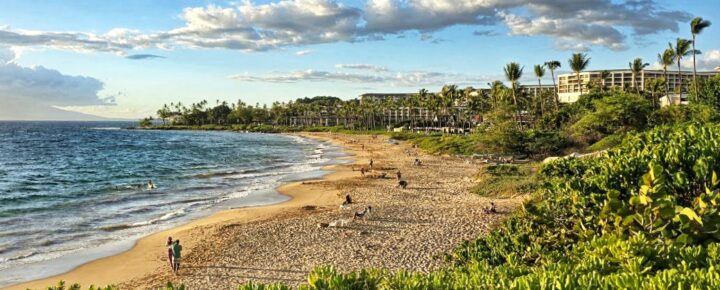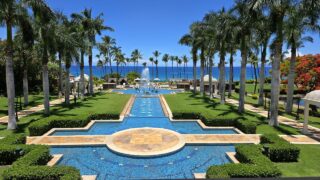Now even the Michelin Guide has weighed in on White Lotus, which started here in Hawaii. They just made it clear that the fictional resorts in the show would never earn a place in their prestigious hotel selection. The hit series, which first was filmed at Four Seasons Resort Maui, transformed the idea of a luxury Hawaiian vacation into something far from relaxing. The show paints a picture of opulence that is both coveted and absurd. But how close does it come to reality? While White Lotus captures some truths about Hawaii’s high-end resorts, it also takes major liberties that really don’t reflect the Hawaii resort experience. So how accurate is Michelin’s critique? Let’s break down what White Lotus got right—and what it exaggerated beyond recognition.
Hawaii’s luxury resorts deliver true five-star settings—but not always five-star service.
One of the strengths of White Lotus is its setting. The real Grand Wailea Maui and other high-end resorts in Hawaii certainly look the part, with stunning oceanfront locations, sprawling pools, and lush tropical landscapes. But while these properties exude luxury, at least on the surface, service quality can be a different and highly varied story.
As we’ve detailed in our recent reviews, Hilton Hawaiian Village has struggled with its massive scale and trying to bring the immense property up to date. It often felt chaotic and impersonal rather than exclusive and polished. Similarly, Renaissance Honolulu was noted for significant management missteps and service failures that don’t align with the expectations of a premium Hawaii stay.
This contrasts somewhat with how White Lotus portrays Hawaii’s luxury hotels. The show suggests that service staff are either over-involved in guests’ lives (something we’ve never found) or entirely indifferent (that’s far closer to the truth at times), or treating hospitality as performance art. While real Hawaii resorts aren’t quite as theatrical as White Lotus portrays, they do face serious service consistency issues—a reality that aligns with the Michelin Guide critique of White Lotus-style resorts.
Resort isolation isn’t always a good thing.
One thing White Lotus does highlight well is how some Hawaii resorts can feel like a world of their own. Many five-star properties are built to be largely self-contained experiences, with on-site fine dining, a plethora of curated activities, shopping, and exquisite beaches. For guests who just want to lounge by the infinity pool and enjoy mai tais, it’s easy to stay on property and never step foot beyond the resort.
But in contrast to the show, real Hawaii travel is about more than just resort life. A major critique of White Lotus’s depiction of Hawaii is its lack of meaningful cultural connection. While real resorts do offer experiences like hula performances, lei-making, and Hawaiian music, the best trips to Hawaii go far beyond hotel grounds. Visitors looking for an authentic experience will find it through local food, hikes, historical sites, and interactions with Hawaii’s residents—things that never seem to happen at The White Lotus.
Luxury dining is a world apart from the show’s single restaurant drama.
In White Lotus, the hotel seems to have just one restaurant, where every meal is a stage for tension, awkward encounters, and backstabbing. In reality, Hawaii’s top resorts feature varied mid to high-end dining options, often with menus curated by local award-winning chefs. The idea that a luxury resort would limit guests to a single dining space is not realistic.
Places like the Four Seasons Maui, Halekulani on Oahu, and the Ritz-Carlton Kapalua on Maui offer diverse culinary experiences, from fresh island seafood to globally-inspired tasting menus. Guests at these resorts can enjoy breakfast overlooking the ocean, upscale sushi dining experience, or a casual poolside meal—all without bumping into their nemesis from the prior evening. The Michelin Guide critique also noted that real top-tier hotels provide an array of culinary experiences, something that White Lotus ignores in favor of dramatized dining table chaos.
The true cost of paradise: luxury in Hawaii comes at a steep price.
Where White Lotus is fairly accurate is in showcasing the exclusivity and expense of Hawaii’s top-tier resorts. Staying at a place like the Four Seasons Maui isn’t for the budget traveler. Room rates often start at $1,000 per night and go far higher, and that’s before extras like dining, spa treatments, and excursions. The show correctly captures how these high-end properties cater to the ultra-wealthy and create an insulated environment where guests rarely need interact with anyone outside their social sphere.
However, White Lotus doesn’t touch on some of the hidden costs that real Hawaii travelers encounter. From resort fees and 18% room tax, to hugely premium pricing on food and drinks, a stay at a luxury resort in Hawaii can quickly add up. Unlike the fictional White Lotus, where the price tag is mostly not discussed, real guests in Hawaii will undoubtedly feel the financial weight of paradise.
No, your Hawaii vacation won’t turn into a thriller.
Ultimately, White Lotus is a satire rather than a travel documentary. While it gets certain aspects of Hawaii and other destination’s luxury resorts right—the beauty, the exclusivity, the high-end service—it takes creative liberties to an extreme when it comes to guest and staff behavior. An actual vacation at a five-star Hawaii resort is more likely to be filled with sun, relaxation, and hopefully great hospitality, rather than deception, intrigue and murder plots.
The White Lotus Season 3 which starts this weekend was set at Ko Samui Thailand.
For those looking to experience what they have seen of Hawaii luxury travel in White Lotus, the takeaway is this: enjoy the beauty, but leave the drama to TV.
Get Breaking Hawaii Travel News







Given the Michelin Guide’s snub of the White Lotus resorts, do you think this is a reflection of the guide’s outdated criteria or a missed opportunity for them to recognize a new standard of luxury travel that prioritizes experience over traditional culinary and accommodation excellence?
I guess I’ll need to Google this show. I’ve never heard of it.
Ah, it’s on HBO Max. That’s why I’ve never heard of it.
As a frequent Maui & BI resort stay couple I’d agree with much of what was written except this part “it takes creative liberties to an extreme when it comes to guest and staff behavior”
We’ve witnessed a lot of staff and guest insane behavior usually during conventions. Holly crap the stories I can tell including prostitutes, orgies and drugs.
There was this one year at Grand Wailea during a nurses convention. Oh my god those nurses could party they were out of control there was so much staff and guest interaction, drama, Kat fights better then anything on White Lotus.
There’s a statue of a Hawaiian native over looking the activity pool at GW nurses were taking turns humping it. It was great.
Then there was the convention of new car dealers at FS Hualalai where the whole convention was asked to leave, but the dealer in charge had a little talk with management where a little cash exchanged and we were allowed to stay.
I have dozens of stories like these.